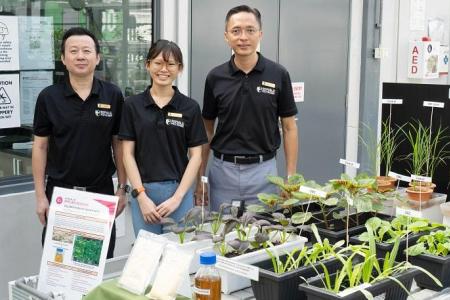Researchers turn okara meant for landfill to crop booster
About 30 tonnes of soya pulp are produced in Singapore every day. That’s equivalent to the weight of about five large elephants.
Soya pulp, or okara, is generated in the production of soymilk and tofu. Indigestible by humans due to its high fibre content, it is often destined for the landfills.
But one man’s quest to repurpose the sheer amount of okara waste has led a research group from Republic Polytechnic to squeeze value from the little legume, turning trash into treasure.
Dr Heng Kiang Soon, a nutritionist by training and lecturer at Republic Polytechnic, has used okara to create a biostimulant for enhancing crop yield and quality, known as Okara Biostimulant Concentrate (OBC).
Biostimulants are like immunity supplements for plants. Unlike fertilisers, which directly provide the plant with nutrients, biostimulants increase the plants’ resistance to disease and climate stress, making them more resilient.
Having grown up on a farm in Malaysia, Dr Heng is passionate about the agricultural industry. So, when Singapore announced its 30-by-30 goal, to produce 30 per cent of the Republic’s nutritional needs domestically by 2030, he started to look into repurposing food waste for both food consumption and agricultural applications.
“(Okara) is termed as food waste, but to me, it’s just the side stream of food processing,” said Dr Heng, noting that like coffee grounds, okara is still fragrant and rich in nutrients.
Food waste can serve as a new source of nutrients – the only thing lacking was the technology to transform it to a higher-value product, he said.
Dr Heng and his team got to work developing a technology to break down the insoluble fibre, unlocking its nutritious properties. After months of experimenting with different enzymes, microbes and fermenters, they ended up with a good method to make the insoluble fibre soluble.
This solubilisation resulted in a smooth, creamy paste that could be digested by humans. The team created a line of okara-based products, such as soy cream cheese, soy cheese, and soy soup, which are in the process of being commercialised.
This was a significant discovery, but solubilised okara also has a drawback, being perishable because of its high moisture content. Freezing is a natural solution, but it is energy and space-consuming.
By further purifying and extracting the nutritional compounds beneficial for plants from the solubilised okara, Dr Heng derived OBC, a clear amber liquid stable at room temperature.
One kilogram of raw okara can produce one litre of OBC in a mere 10 hours. The process was shortened from five days through a series of trial and error, experimenting with time, temperature and different biological reagents.
Since OBC is a concentrate, only a tiny amount is needed, diluted with water and applied to the roots of young plants, or incorporated into watering systems for more mature plants.
Tested on five farms in Singapore, Indonesia, Thailand and the United States, on leafy greens to musk melons, OBC showed it could increase crop yield by 15 to 50 per cent. Soil-based vegetables do even better, as the soil provides a greater amount and diversity of nutrients than hydroponic solutions, said Dr Heng.
In testing, the OBC shortened the growth cycle of leafy greens from 30 days to 25, generating more rounds of cultivation. Strawberries, which are often plagued by a fungal disease known as powdery mildew, saw a reduction of this disease.
Ultimately, Dr Heng wants to “close the loop” on soya waste, returning food waste to food production. Trials are currently underway at Virginia Tech in the US to assess the effect of OBC on the growth of soy plants, and RP is researching ways to create an edible fruit coating with the leftover cellulose that can replace plastic wraps on fruit.
The intellectual property rights of this technology have been licensed to SoiLabs, a local food technology company.
“This (technology) allows us to solve the waste disposal problem for soy producers by converting it into an intermediate product that can initially be transformed into a food product, but also into numerous high value-added products,” said chief executive of SoiLabs Mauro Catellani.
OBC is also being used by health consultant Shafaye Ong, the owner of a small community farm plot in Khatib.
Motivated to bid for a community farm plot when her 6-year-old son declared he “wanted to grow a potato”, Ms Ong gained a liking for farming.
She sees farming with OBC as a means of promoting more healthy living. “Besides our emphasis on eating as much as we can, a variety of food, (home-grown crops) can also be a form of variation on the food that we take in,” she said.
While OBC is currently not being sold on a widespread, commercial scale, SoiLabs is conducting further trials on local and overseas farms, marketing the product globally through “targeted collaborations for each specific market segment”, says Dr Catellani.
Get The New Paper on your phone with the free TNP app. Download from the Apple App Store or Google Play Store now


